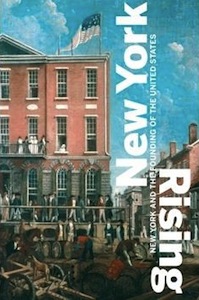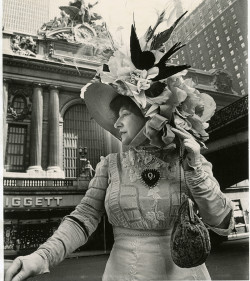New-York Historical Society
More Fascinating Facts for The New York Historical
New York Rising, by Valerie Paley
 After suffering seven years of British occupation, New York City emerged from the Revolutionary War confident about the prospects of the new American nation. As the first capital of the United States, New York was the epicenter of intellectual debate, and citizens of every description came to the city.
After suffering seven years of British occupation, New York City emerged from the Revolutionary War confident about the prospects of the new American nation. As the first capital of the United States, New York was the epicenter of intellectual debate, and citizens of every description came to the city.
The port surged with activity. Coffeehouses were abuzz with the latest commercial news and political maneuvering, and the streets were abuzz with possibility, ambition, and talent. Even as it rebuilt an infrastructure that had been reduced to rubble and restored a populace decimated by war, the city quickly developed into the leading center of maritime commerce, information, and an expanding political culture.
Revolution: For most of the war, New York was occupied by the British Army and the Royal Navy, and the city served as their North American headquarters. Yet prior to becoming a Loyalist stronghold, New York was a hotbed of Revolutionary agitation and dissent. From the toppling of the statue of King George III at Bowling Green to the treachery of Benedict Arnold,  the bravery of Nathan Hale, the misery of the prison ships, and the creation of the Society of the Cincinnati, New York was the setting for some of the most heroic moments of the era. Out of chaos and destruction rose a powerful and vibrant city.
the bravery of Nathan Hale, the misery of the prison ships, and the creation of the Society of the Cincinnati, New York was the setting for some of the most heroic moments of the era. Out of chaos and destruction rose a powerful and vibrant city.
Marketplace: On May 17, 1792, under a buttonwood tree near Wall Street, 24 stockbrokers gathered to sign an agreement that would serve as a precursor to the New York Stock Exchange Board, the predecessor of the New York Stock Exchange. The brokers would perform their transactions in a second-floor room of the Tontine Coffee House. At the time, financial and political wrangling often took place in taverns and coffeehouses. At the Tontine, self-made men — both black and white — traded gossip and conducted business. Ship captains came to share commercial news and to register cargo — including the human cargo of enslaved men, women, and children. The mercantile city was also crowded and unsanitary, and frequent outbreaks of infectious disease not only hastened the growth of the city northward, away from the crowded downtown, but also propelled strides forward in medical research and treatment.
Capital: It was on the balcony of Federal Hall, in lower Manhattan, that George Washington was inaugurated as the president of the United States in 1789. The remarkable in itself, the inauguration was only one of a series of legislative and diplomatic milestones that occurred between 1785 and 1790, when New York served as the national capital. For Washington and his contemporaries, the city was a laboratory in which the ideals that had inspired the Revolution would be tested. It was here that Washington and others began consciously crafting an American identity; that venues like Fraunces Tavern became the first offices for government officials like John Jay and Alexander Hamilton; and that an American Indian named Cornplanter protested against white western expansion. From taste-making to the Bill of Rights, it is this era in which the histories of the city and the new nation converged for the first time.
Politics: On July 11, 1804, Alexander Hamilton was mortally wounded in a duel with the vice president of the United States, Aaron Burr. The duel was the final act of an “affair of honor,” a highly ritualized war of words between two men looking to protect their personal and political reputations. When Hamilton died the next day, he left a widow in debt and a city in mourning, and Burr found himself disgraced. This tragic event encapsulated the partisan, petty, and frequently scandal-ridden politics of Federalist-era New York. Alongside high-minded debate over national public policy, political leaders dealt in innuendo and personal attacks, using the press to discredit their opponents. As men jockeyed to define their position within the new nation, women worked to balance their traditional responsibilities with new opportunities — through education and acceptable public roles, such as those for private charities that focused on children and the poor.
Information below is excepted from “New York and the Founding of the United States,” published by the New-York Historical Society Museum and Library




